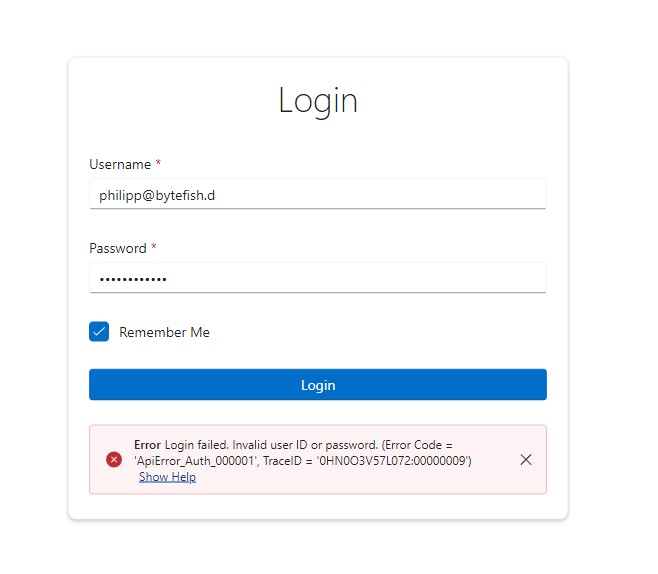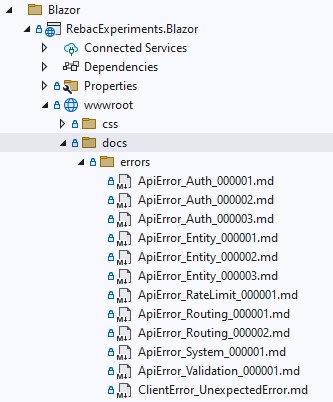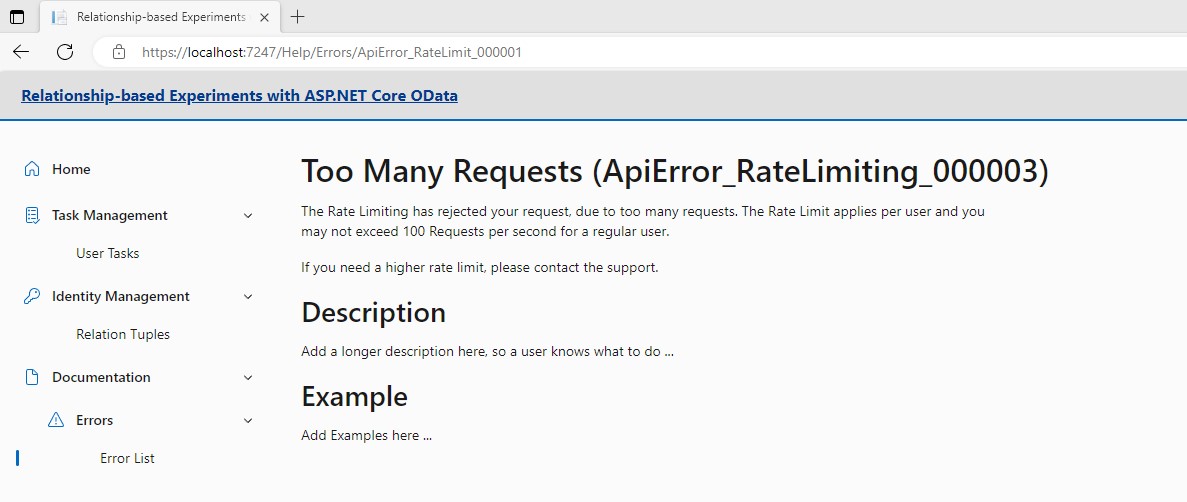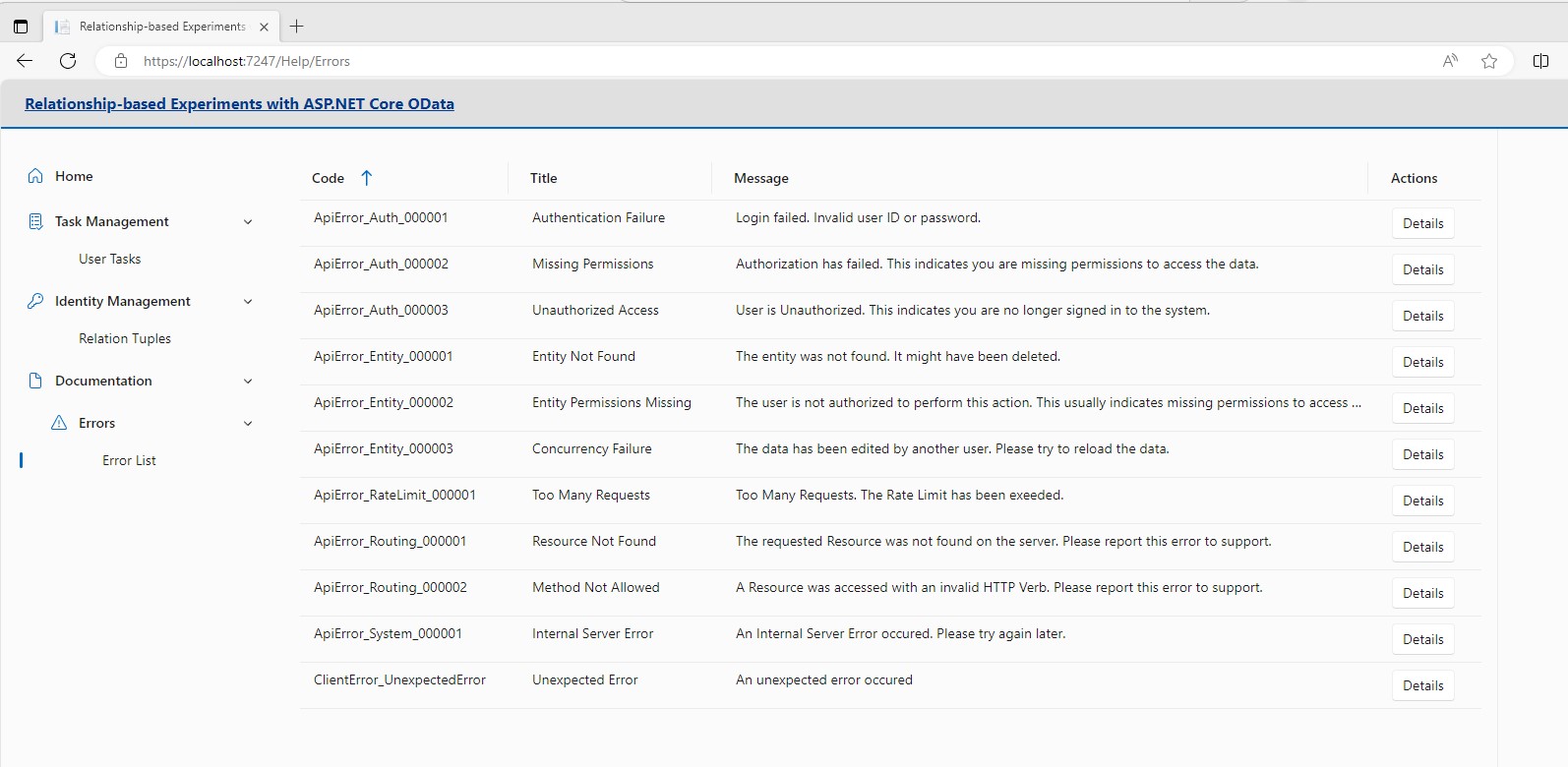In my last post I have shown how to provide consistent error handling within an ASP.NET Core OData application, and we have seen how to display localized messages in the Blazor Web Assembly client.
This is great!
But imagine for a second you are using your software and you hit a bug. It's frustrating! It's even more frustrating if you don't know what the error means. Am I at fault? Did I use a wrong input format? Has someone given me an invalid link? Do I lack permissions to access the data?
In this article we will see how to give the user additional feedback and help to understand errors.
At the end of the article we will have a flexible way to provide error messages with a link to additional information about possible error reasons. The documentation is written in Markdown:
The code has been taken from the Git Repository at:
Table of contents
ASP.NET Core Implementation
So the most obvious solution for me is to write the error documentation in Markdown, put it in the
wwwroot of the Blazor application and use a Markdown processor like Markdig to convert it down to
HTML. Sanitized HTML will then be used in the Blazor Component.
That said, I personally don't think, that Markdown is well suited for complex software documentation. I have previously worked with professional help authoring tools to provide single source publishing, and Markdown wouldn't be the right tool for the job.
Anyways... Let's use Markdown!
Markdown Content for Error Codes
I start by creating a new folder /docs/errors in the wwwroot directory. For each of the available
error codes in the application I put a Markdown file there, like ApiError_Auth_000001.md:
The content should be some kind of help page for a user, so they know about possible problems. It's not very creative, what I came up with here, but you get the point.
# Authentication Failure (ApiError_Auth_000001)
The Authentication has failed. This indicates a problem to log in to the application, which
may be due to an invalid combination of a username and password, or the account is not permitted
to log in.
Please try to contact the support, if the problem persists.
## Description
Add a longer description here, so a user knows what to do ...
## Example
Add Examples here ...
A Blazor Component for rendering Markdown Content
The Fluent UI documentation has a nice example for a Markdown component at:
It goes like this.
The MarkdownSection.razor component inherits the FluentComponentBase and just uses the HtmlContent defined in the Code-Behind:
@namespace RebacExperiments.Blazor.Components
@inherits FluentComponentBase
@HtmlContent
In the MarkdownSection.razor.cs file, we can then convert from Markdown to HTML. The sanitized HTML is stored
in a MarkupString, which the Razor Component binds to:
// Licensed under the MIT license. See LICENSE file in the project root for full license information.
using Markdig;
using Microsoft.AspNetCore.Components;
using Microsoft.FluentUI.AspNetCore.Components;
using RebacExperiments.Blazor.Infrastructure;
namespace RebacExperiments.Blazor.Components
{
/// <summary>
/// This is based on https://www.fluentui-blazor.net/Lab/MarkdownSection.
/// </summary>
public partial class MarkdownSection : FluentComponentBase
{
private string? _content;
private bool _raiseContentConverted;
[Inject]
private IStaticAssetService StaticAssetService { get; set; } = default!;
/// <summary>
/// Gets or sets asset to read the Markdown from.
/// </summary>
[Parameter]
public required string FromAsset { get; set; }
/// <summary>
/// Raised, when the Content has been converted.
/// </summary>
[Parameter]
public EventCallback OnContentConverted { get; set; }
/// <summary>
/// Sanitized HTML Content.
/// </summary>
public MarkupString HtmlContent { get; private set; }
public string? InternalContent
{
get => _content;
set
{
_content = value;
HtmlContent = ConvertToMarkupString(_content);
if (OnContentConverted.HasDelegate)
{
OnContentConverted.InvokeAsync();
}
_raiseContentConverted = true;
StateHasChanged();
}
}
protected override async Task OnInitializedAsync()
{
InternalContent = await StaticAssetService.GetAsync(FromAsset);
if (_raiseContentConverted)
{
_raiseContentConverted = false;
if (OnContentConverted.HasDelegate)
{
await OnContentConverted.InvokeAsync();
}
}
}
private static MarkupString ConvertToMarkupString(string? value)
{
if (!string.IsNullOrWhiteSpace(value))
{
// Convert markdown string to HTML
string? html = Markdown.ToHtml(value, new MarkdownPipelineBuilder().UseAdvancedExtensions().Build());
// Return sanitized HTML as a MarkupString that Blazor can render
return new MarkupString(html);
}
return new MarkupString();
}
}
}
The IStaticAssetService is an implementation by the Fluent UI team at:
An Error Details Page using the MarkdownSection
All that now needs to be done is to pass an ErrorCode for the Route and use the <MarkdownSection>, which is
going to load the Markdown content and render it.
@page "/Help/Errors/{ErrorCode}"
@using RebacExperiments.Blazor.Components
@namespace RebacExperiments.Blazor.Pages
@inject ApplicationErrorTranslator ApplicationErrorTranslator
<style>
p {
max-width: 700px;
}
</style>
@if (!string.IsNullOrWhiteSpace(_assetUrl))
{
<MarkdownSection FromAsset=@_assetUrl />
}
else
{
<p>Loading Error Information ...</p>
}
In the Code-Behind we can see, that all it does is to build the AssetUrl.
// Licensed under the MIT license. See LICENSE file in the project root for full license information.
using Microsoft.AspNetCore.Components;
namespace RebacExperiments.Blazor.Pages
{
public partial class ErrorDetail
{
/// <summary>
/// Gets or sets the Error Code to view information for.
/// </summary>
[Parameter]
public string? ErrorCode { get; set; }
private string? _assetUrl;
protected override void OnParametersSet()
{
if(ErrorCode != null)
{
_assetUrl = $"/docs/errors/{ErrorCode}.md";
}
}
}
}
You can now navigate to an Address like /Help/Errors/ApiError_RateLimit_000001 (Rate Limiting) and you will see beautiful Markdown being rendered:
Extracting Error Information of an Exception
The ApiClient the application is using to perform requests throws an ODataError, if a request has failed. In the
previous article, we have developed an ApplicationErrorTranslator to extract the Error information from a given
Exception.
// Licensed under the MIT license. See LICENSE file in the project root for full license information.
using Microsoft.Extensions.Localization;
using RebacExperiments.Blazor.Localization;
using RebacExperiments.Shared.ApiSdk.Models.ODataErrors;
using System.Diagnostics.CodeAnalysis;
namespace RebacExperiments.Blazor.Infrastructure
{
public class ApplicationErrorTranslator
{
private readonly IStringLocalizer<SharedResource> _sharedLocalizer;
public ApplicationErrorTranslator(IStringLocalizer<SharedResource> sharedLocalizer)
{
_sharedLocalizer = sharedLocalizer;
}
public (string ErrorCode, string ErrorMessage) GetErrorMessage(Exception exception)
{
return exception switch
{
ODataError e => (e.Error!.Code!, GetErrorMessageFromODataError(e)),
Exception e => (LocalizationConstants.ClientError_UnexpectedError, GetErrorMessageFromException(e)),
};
}
private string GetErrorMessageFromODataError(ODataError error)
{
// Extract the ErrorCode from the OData MainError.
string errorCode = error.Error!.Code!;
// And get the Error Message by the Error Code.
string errorCodeMessage = _sharedLocalizer[errorCode];
// Format with Trace ID for correlating user error reports with logs.
if(TryGetRequestTraceId(error.Error!, out string? traceId))
{
return $"{errorCodeMessage} (Error Code = '{errorCode}', TraceID = '{traceId}')";
}
return $"{errorCodeMessage} (Error Code = '{errorCode}')";
}
private string GetErrorMessageFromException(Exception e)
{
string errorMessage = _sharedLocalizer["ApplicationError_Exception"];
return errorMessage;
}
private bool TryGetRequestTraceId(MainError mainError, [NotNullWhen(true)] out string? requestTraceId)
{
requestTraceId = null;
if(mainError.Innererror == null)
{
return false;
}
var innerError = mainError.Innererror;
if(!innerError.AdditionalData.ContainsKey("trace-id"))
{
return false;
}
requestTraceId = innerError.AdditionalData["trace-id"] as string;
if(requestTraceId == null)
{
return false;
}
return true;
}
}
}
Showing the Errors in a FluentUI Message Bar
We can then use the Fluent UI MessageBar to display the error. We wrap the MessageService
// Licensed under the MIT license. See LICENSE file in the project root for full license information.
using Microsoft.AspNetCore.Components;
using Microsoft.Extensions.Localization;
using Microsoft.FluentUI.AspNetCore.Components;
using RebacExperiments.Blazor.Localization;
namespace RebacExperiments.Blazor.Infrastructure
{
public class ApplicationErrorMessageService
{
private readonly IStringLocalizer<SharedResource> _sharedLocalizer;
private readonly ApplicationErrorTranslator _applicationErrorTranslator;
private readonly IMessageService _messageService;
private readonly NavigationManager _navigationManager;
public ApplicationErrorMessageService(IStringLocalizer<SharedResource> sharedLocalizer, IMessageService messageService, NavigationManager navigationManager, ApplicationErrorTranslator applicationErrorTranslator)
{
_sharedLocalizer = sharedLocalizer;
_navigationManager = navigationManager;
_applicationErrorTranslator = applicationErrorTranslator;
_messageService = messageService;
}
public void ShowErrorMessage(Exception exception, Action<MessageOptions>? configure = null)
{
(var errorCode, var errorMessage) = _applicationErrorTranslator.GetErrorMessage(exception);
_messageService.ShowMessageBar(options =>
{
options.Section = App.MESSAGES_TOP;
options.Intent = MessageIntent.Error;
options.ClearAfterNavigation = false;
options.Title = _sharedLocalizer["Message_Error_Title"];
options.Body = errorMessage;
options.Timestamp = DateTime.Now;
options.Link = new ActionLink<Message>
{
Text = _sharedLocalizer["Message_ShowHelp"],
OnClick = (message) =>
{
_navigationManager.NavigateTo($"Help/Errors/{errorCode}");
return Task.CompletedTask;
}
};
// If we need to customize it like using a different section or intent, we should
// use the action passed to us ...
if(configure != null )
{
configure(options);
}
});
}
}
}
In the Login Page we will then add a <FluentMessageBarProvider Section="@App.MESSAGES_TOP" />, which basically is
the placeholder, where Fluent UI displays the Messages.
@page "/Login"
@layout EmptyLayout
@using RebacExperiments.Shared.ApiSdk
@inject ApiClient ApiClient
@inject IStringLocalizer<SharedResource> Loc
@inject NavigationManager NavigationManager
@inject CustomAuthenticationStateProvider AuthStateProvider
@inject ApplicationErrorMessageService ApplicationErrorMessageService
<div class="container">
<FluentCard Width="500px">
<EditForm Model="@Input" OnValidSubmit="SignInUserAsync" FormName="login_form" novalidate>
<FluentStack Orientation="Orientation.Vertical">
<FluentGrid Spacing="3" Justify="JustifyContent.Center">
<!-- ... -->
<FluentGridItem xs="12">
<FluentMessageBarProvider Section="@App.MESSAGES_TOP" />
</FluentGridItem>
</FluentGrid>
</FluentStack>
</EditForm>
</FluentCard>
</div>
In the Code-Behind we can then put our code in a try-catch block, and handle the Exception where it is thrown.
// Licensed under the MIT license. See LICENSE file in the project root for full license information.
// ...
namespace RebacExperiments.Blazor.Pages
{
public partial class Login
{
/// <summary>
/// Data Model for binding to the Form.
/// </summary>
private sealed class InputModel
{
/// <summary>
/// Signs in the User to the Service using Cookie Authentication.
/// </summary>
/// <returns></returns>
public async Task SignInUserAsync()
{
try
{
// ...
}
catch(Exception e)
{
ApplicationErrorMessageService.ShowErrorMessage(e);
}
}
Adding an ErrorBoundary to the MainLayout
Sometimes you have an Exception, that bubbles up your component. To prevent crashing everything, we put an ErrorBoundary into the layout,
so we catch it there... as some kind of "Global Error Handling".
<!-- ... -->
@inject ApplicationErrorMessageService ApplicationErrorMessageService
<!-- ... -->
<article id="article">
<FluentMessageBarProvider Section="@App.MESSAGES_TOP" />
<ErrorBoundary @ref="_errorBoundary">
<ChildContent>
<div>@Body</div>
</ChildContent>
<ErrorContent Context="exception">
@{
ApplicationErrorMessageService.ShowErrorMessage(exception);
}
</ErrorContent>
</ErrorBoundary>
</article>
<!-- ... -->
Providing a List of Errors
Sometimes a user wants to see the list of all errors available. Maybe they got an error message or need
to research a problem, someone integrating the service has. A FluentDataGrid is a nice way to present
the information.
@page "/Help/Errors"
@using RebacExperiments.Blazor.Components
@namespace RebacExperiments.Blazor.Pages
@inject NavigationManager NavigationManager
@inject IStringLocalizer<SharedResource> Loc
<FluentDataGrid Items="@Errors" ResizableColumns=true GridTemplateColumns="0.2fr 0.2fr 1fr 0.2fr" TGridItem="ErrorListItem">
<PropertyColumn Property="@(c => c.Code)" Sortable="true" Align="Align.Start" />
<PropertyColumn Property="@(c => c.Title)" Sortable="true" Align="Align.Start" />
<PropertyColumn Property="@(c => c.Message)" Sortable="true" Align="Align.Start" />
<TemplateColumn Title="Actions" Align="@Align.Start">
<FluentButton OnClick="@(() => ShowDetails(context))">@Loc["DataGrid_Button_Details"]</FluentButton>
</TemplateColumn>
</FluentDataGrid>
In the Code-Behind we are going to list all application errors manually. You could come up with less verbose ideas for, but hey, it's simple and it works good.
// Licensed under the MIT license. See LICENSE file in the project root for full license information.
using Microsoft.AspNetCore.Components;
namespace RebacExperiments.Blazor.Pages
{
public partial class ErrorDataGrid
{
public class ErrorListItem
{
public required string Code { get; set; }
public required string Title { get; set; }
public required string Message { get; set; }
}
private IQueryable<ErrorListItem> Errors = new List<ErrorListItem>().AsQueryable();
protected override void OnInitialized()
{
Errors = new List<ErrorListItem>()
{
new ErrorListItem { Code = "ClientError_UnexpectedError", Title = "Unexpected Error", Message = Loc["ClientError_UnexpectedError"] },
new ErrorListItem { Code = "ApiError_Auth_000001", Title = "Authentication Failure", Message = Loc["ApiError_Auth_000001"] },
new ErrorListItem { Code = "ApiError_Auth_000002", Title = "Missing Permissions", Message = Loc["ApiError_Auth_000002"]},
new ErrorListItem { Code = "ApiError_Auth_000003", Title = "Unauthorized Access", Message = Loc["ApiError_Auth_000003"] },
new ErrorListItem { Code = "ApiError_Entity_000001", Title = "Entity Not Found", Message = Loc["ApiError_Entity_000001"] },
new ErrorListItem { Code = "ApiError_Entity_000002", Title = "Entity Permissions Missing", Message = Loc["ApiError_Entity_000002"] },
new ErrorListItem { Code = "ApiError_Entity_000003", Title = "Concurrency Failure", Message = Loc["ApiError_Entity_000003"] },
new ErrorListItem { Code = "ApiError_RateLimit_000001", Title = "Too Many Requests", Message = Loc["ApiError_RateLimit_000001"] },
new ErrorListItem { Code = "ApiError_Routing_000001", Title = "Resource Not Found", Message = Loc["ApiError_Routing_000001"] },
new ErrorListItem { Code = "ApiError_Routing_000002", Title = "Method Not Allowed", Message = Loc["ApiError_Routing_000002"] },
new ErrorListItem { Code = "ApiError_System_000001", Title = "Internal Server Error", Message = Loc["ApiError_System_000001"] },
}
.AsQueryable();
}
private void ShowDetails(ErrorListItem errorListItem)
{
NavigationManager.NavigateTo($"/Help/Errors/{errorListItem.Code}");
}
}
}
Conclusion
And that's it.
In this article we have seen how to render Markdown content in a Blazor application. It was used to provide
help pages, that a user can navigate to when an Error is shown within the Client. The Errors can be handeled
either directly in the component, or they are caught in an ErrorBoundary of the default layout.
I am not saying this is the perfect way to implement your Error handling with Blazor. But I think it works
pretty well, because a simple try-catch is sufficient to display the errors in the User Interface. And any
Exception that slips through, is still going to be caught in the last line of defense... the
ErrorBoundary.



